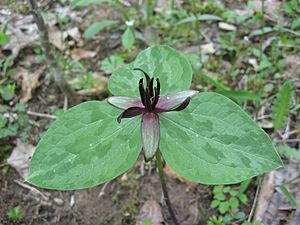Twisted trillium facts for kids
Quick facts for kids Twisted trillium |
|
|---|---|
 |
|
| flower and foliage | |
| Conservation status | |
| Scientific classification | |
| Genus: |
Trillium
|
| Species: |
stamineum
|
| Synonyms | |
|
|
The Trillium stamineum, often called the twisted trillium or Blue Ridge wakerobin, is a type of flowering plant. It belongs to the plant family called Melanthiaceae. This plant grows naturally in the southeastern United States. You can find it in Alabama, Mississippi, and Tennessee. It likes to grow in woodlands where the soil has a lot of calcium.
In 1901, a scientist named Harbison studied Trillium stamineum. He noticed it had a fuzzy stem and unique petals. Its stamens (the parts that hold pollen) stand up straight.
About the Twisted Trillium
The twisted trillium is a perennial plant. This means it lives for many years. It's also an herbaceous plant, which means it has soft stems, not woody ones like a tree. It spreads underground using special stems called rhizomes.
The plant has a stem that grows from its underground rhizome. This stem can be about 15 to 30 cm (5.9 to 11.8 in) tall. It has three leaf-like parts called bracts. These bracts grow in a circle, or whorl, around the stem. The stem itself is a bit fuzzy. The bracts are shaped like an egg. They are about 6.3 to 7.6 cm (2.5 to 3.0 in) long and 3.3 to 5 cm (1.3 to 2.0 in) wide. They are bluish-green and have cool patterns, but these patterns fade as the plant gets older.
Flowers and Life Cycle
Trillium stamineum flowers between March and May. The exact time depends on how far north or south it is. It grows one flower right on top of its leaves.
What makes this trillium special is how its petals grow. Unlike other trilliums, its petals spread out flat. This shows off its stamens, which stand up straight. These stamens are about 16 to 24 mm (0.6 to 0.9 in) long. The petals are a dark maroon color. They are about 1.5 to 2.8 cm (0.6 to 1.1 in) long and 0.3 to 0.6 cm (0.1 to 0.2 in) wide. They have a cool twist along their length, which is why it's called the "twisted trillium."
The flower of this plant has a smell like rotting meat. This smell helps to attract flies and other insects. These insects then help the plant with pollination, which means they help the plant make seeds.
All parts of the flower are purple or dark purple. This includes the stamens, the parts that hold pollen, and the ovary, which holds the seeds. Even the fruit of the plant is purple. In 1975, a scientist found a type of Trillium stamineum that didn't have any purple color. He called it Trillium stamineum f. luteum. However, this name is now considered the same as the main species.


